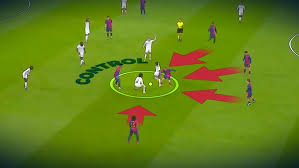Explore the evolution of pressing and possession-based football in the modern game. Learn how these tactical approaches have transformed football strategies and gameplay.
The Modern Game: Pressing and Possession-Based Football
Football has come a long way since its early days, evolving from a simple game of ball and goalposts to a tactical battle of strategy, innovation, and advanced techniques. The modern game is now characterized by the use of dynamic pressing systems and possession-based football, both of which have redefined the way teams approach their matches. These two tactical principles — pressing and possession — have become crucial components of contemporary football, shaping the playstyles of some of the most successful teams in recent years.
In this article, we delve into the significance of pressing and possession-based football, examining how these strategies have emerged, their impact on the modern game, and the teams and players who have mastered them. By the end, you’ll gain a deeper understanding of how these philosophies are shaping the future of football.
1. The Evolution of Football Tactics
Football, as a sport, has undergone several transformations over the years. From the WM formation to 4-4-2, tactical systems have continuously evolved to counter the ever-changing demands of the game. The introduction of pressing and possession-based football is arguably one of the most significant tactical revolutions of the 21st century.
The Roots of Pressing and Possession
Historically, football focused primarily on simple attacking and defending strategies. However, the emergence of total football in the 1970s, pioneered by Johan Cruyff and the Dutch national team, laid the groundwork for modern tactical concepts. The foundation for possession-based football began to take shape, influencing clubs like FC Barcelona and Bayern Munich, who took it to new heights with refined techniques.
On the other hand, pressing tactics began gaining attention in the early 2000s, as coaches like Jürgen Klopp and Ralf Rangnick emphasized aggressive pressing and high defensive lines. Their belief that winning the ball back quickly was just as important as attacking possession formed the basis for the pressing systems we see today.
2. The Rise of Pressing Football
Pressing, particularly gegenpressing, has revolutionized football in the 21st century. Gegenpressing, or counter-pressing, is the strategy where a team immediately attempts to win back possession as soon as they lose the ball, denying the opposition any time to transition. This high-intensity, high-risk approach has become synonymous with teams that play a quick, dynamic brand of football.
The Impact of Jürgen Klopp
Jürgen Klopp is perhaps the most famous proponent of gegenpressing. His time at Borussia Dortmund and, more recently, Liverpool has shown just how effective pressing can be in modern football. Klopp’s Liverpool has utilized gegenpressing with remarkable success, quickly closing down the opposition as soon as they lose possession, often leading to quick turnovers and fast counter-attacks.
The high press employed by Klopp’s teams has been incredibly effective at disrupting opposition play. By forcing teams into hurried decisions, his players are able to win the ball back high up the pitch and exploit any spaces left by the opposition. This has led to both offensive brilliance and defensive stability, with Liverpool becoming one of the most dominant teams in Europe.
Other Pressing Innovators
Alongside Klopp, Pep Guardiola has also embraced pressing as part of his tactical setup. Guardiola’s Manchester City has become known for their suffocating press, which works in tandem with their possession game. By pressing high up the pitch, Manchester City not only denies opposition teams time and space but also ensures that they can regain the ball quickly in advanced positions, creating numerous goal-scoring opportunities.
The philosophy of pressing has also taken hold in RB Leipzig, Bayern Munich, and Atletico Madrid, where coaches like Julian Nagelsmann, Hans-Dieter Flick, and Diego Simeone have adopted similar principles of high-pressure football.
3. Possession-Based Football: The Art of Controlling the Game
Possession-based football, in contrast, focuses on controlling the ball and dictating the tempo of the game. Rather than chasing the ball or forcing turnovers, teams that play possession-based football prioritize maintaining control, wearing down the opposition with precise passing, and breaking them down with intricate build-up play.
The Legacy of Barcelona
FC Barcelona remains one of the most iconic examples of possession-based football, largely due to their successful implementation of tiki-taka under Pep Guardiola. Tiki-taka, a style of play that emphasizes short, quick passes and maintaining possession, became synonymous with Barcelona’s dominance in the late 2000s and early 2010s.
Guardiola’s Barcelona team, featuring legends such as Xavi, Andrés Iniesta, and Lionel Messi, controlled games with an almost obsessive focus on retaining possession. Barcelona’s ability to monopolize the ball frustrated opponents, and their relentless movement off the ball made them virtually impossible to break down. Possession-based football allowed Barcelona to dictate the tempo and wear down opponents with constant pressure.
The tactical philosophy of tiki-taka also heavily influenced other top teams, with Manchester City under Guardiola continuing the tradition of possession football and achieving success with it. Guardiola’s emphasis on fluid passing, positional play, and maintaining control of the ball has been fundamental to Manchester City’s rise as one of the most formidable teams in Europe.
Bayern Munich: A Blend of Possession and Pressing
Under the stewardship of coaches like Jupp Heynckes, Pep Guardiola, and Hans-Dieter Flick, Bayern Munich has adopted a style that combines possession-based football with elements of pressing. Their ability to control the ball while simultaneously pressing aggressively when out of possession has allowed them to become one of the most successful clubs in Europe.
Bayern’s possession game often leads to moments of brilliance, with the likes of Robert Lewandowski, Thomas Müller, and Joshua Kimmich orchestrating attacks from midfield. Bayern’s fluidity in possession allows them to control matches, while their pressing game ensures that they win the ball back as quickly as possible to keep the pressure on their opposition.
4. The Benefits and Drawbacks of Pressing and Possession
While both pressing and possession-based football offer clear advantages, they also come with inherent risks and challenges.
Pressing: The High-Risk, High-Reward Strategy
Pressing, particularly gegenpressing, requires immense stamina, work rate, and coordination among players. A team’s pressing intensity can quickly falter if players do not work in unison, leading to gaps in the defensive structure. Moreover, pressing high up the pitch can leave the team vulnerable to counter-attacks if the opposition manages to break the press. As seen with some of the top teams, when a pressing system works effectively, it can be devastating for the opposition, but if it is not executed properly, it can lead to gaps and potential goals conceded.
Possession: The Need for Precision
Possession-based football requires high levels of technical proficiency and understanding between players. The intricate passing and constant movement can wear down the opposition, but possession teams can be vulnerable if they lose the ball in dangerous areas or if they face well-organized defensive teams that press effectively. Moreover, the reliance on controlling the ball means that possession-based football teams must be patient and disciplined, and sometimes they may struggle to break down compact defensive units.
5. The Future of Pressing and Possession in Football
As football continues to evolve, pressing and possession-based football are likely to remain at the forefront of modern tactics. The integration of advanced data analysis, improved fitness techniques, and innovative coaching methods will only further refine and develop these styles of play. The future of football will likely see more teams adopting hybrid systems, blending both pressing and possession into their tactical philosophies, as coaches continue to adapt to the ever-changing dynamics of the modern game.
With the rise of analytics and the increasing importance of tactical flexibility, the teams that can balance pressing and possession will continue to thrive in the future. Football’s tactical landscape will keep evolving, but pressing and possession will undoubtedly remain central to its development.


